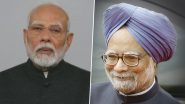New Delhi, August 23: India on Wednesday joined an elite group of three nations to have sent a spacecraft on the moon as Chandrayaan-3 landed a rover on the lunar surface to explore the uncharted territories near the south pole. The erstwhile Soviet Union, the US and China have successfully carried out soft landings on the moon and even getting back to earth samples of soil and rocks from the lunar surface.
India's third lunar mission - Chandrayaan-3 - on Wednesday landed near the South Pole of the moon, a place where no spacecraft has travelled so far.
No other country has been able to land on this side of the moon before; this will change all narratives and stories about the moon, Prime Minister Narendra Modi said. Chandrayaan 3 Moon Landing: Historic Moment for Us, Says PM Narendra Modi As ISRO Spacecraft Makes Historic Soft-Landing on Moon’s South Surface (Watch Video).
Not all these missions were successful in their first attempts, with the then USSR succeeding to make a lunar impact on its sixth space flight. The Luna-2 mission of the Soviet Union crashed on the moon on September 14, 1959, making it the first human-made object to hit another celestial body.
Similarly, the National Aeronautics and Space Administration (NASA) could taste success in the lunar missions on July 31, 1964, after 13 failed attempts to crash land on the moon. NASA's Ranger 7 was a major turning point in the race to the moon as it sent back 4,316 images before crashing into the lunar surface. The photographs helped identify safe Moon landing sites for Apollo astronauts. India Spacecraft First to Land on Moon’s South Pole.
China's Chang'e Project started with orbiter missions to the moon, which generated detailed maps of the lunar surface to identify future sites for soft landings. The Chang'e 3 and 4 missions launched on December 2, 2013 and December 7, 2018 respectively made a soft landing on the lunar surface and operated rovers to explore the moon.
The Chang'e 5 mission was launched on November 23, 2020, landed near the Mons Rumker volcanic formation on the Moon on December 1 and returned to Earth with two kilograms of lunar soil on December 16, the same year. India's lunar missions began with the launch of Chandrayaan 1 on October 22, 2008 that put a spacecraft in a 100 km circular orbit around the moon.
The spacecraft made 3,400 orbits around the Moon at a height of 100 km from the lunar surface and prepared a chemical, mineralogical and photo-geologic mapping of the Moon. The orbiter mission, which had a mission life of two years, was, however, prematurely aborted after communication with the spacecraft was lost on August 29, 2009. Chandrayaan 3 Moon Landing: Historic Moment for Us, Says PM Narendra Modi As ISRO Spacecraft Makes Historic Soft-Landing on Moon's South Pole (Watch Video).
A decade later, Chandrayaan-2, comprising an orbiter, lander and rover, was successfully launched on July 22, 2019. The objectives of the country's second mission to the Moon were scientific studies by payloads onboard the orbiter, and technology demonstration of soft landing and roving on the lunar surface.
However, the space-craft crash landed on the moon on September 6, 2019 due to a software glitch.
(This is an unedited and auto-generated story from Syndicated News feed, LatestLY Staff may not have modified or edited the content body)













 Quickly
Quickly





















